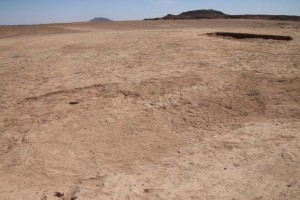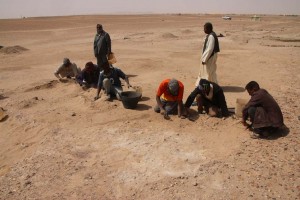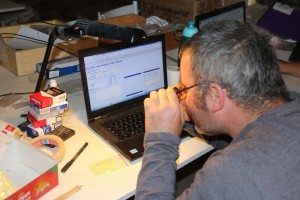This week work focused again on fieldwork in the cemetery SAC5 and registration and studying of various find categories in the dig house.
Excavation in area 1 in the southern part of SAC5 proved to be very interesting: we now know that this large sector set between two small hill outcrops probably was completly void of tombs. No burial monuments were located, but rather various interesting topographical features exposed – Martin Fera will compose a digital landscape model in the next weeks attempting a first interpretation of this topography. The fresh information will allow some new insights into the landscape, evolution and size of the New Kingdom cemetery SAC5.
In agreement with Florence Thill, we started digging another area in SAC5: area 2 is located north of area 1, just next to various 18th Dynasty monuments like tomb 8. The surface material discovered so far covers all the periods attested for the use of SAC5 as a burial site: mid-late 18th Dynasty, Late Ramesside, Pre-Napatan and Napatan.
Today, a sandy depression was found, surrounded on three sides by bedrock – we’ll continue excavating there, of course hoping for a shaft opening belonging to a new tomb.
Feature 15 keeps us busy in the digging house – most of the washing of the ceramics is now done, but sorting is still ongoing. 60 vessels have been reconstructed so far – dozens of more are still waiting to be joined. Oliver Frank Stephan concentrates on drawing the complete profiles and reconstructed pots. Registration of finds from feature 15 continued – Ken Griffin and Meg Gundlach have been very productive in entering different types of objects into the database. By now, a total of 329 small finds were registered from feature 15! And I am not yet done with sieving, some bags with material from directly above the pavement are still unchecked, for sure comprising more objects. Already 171 seal impressions were documented, mostly dating to Hatshepsut and Thutmose III. We continue to be a bit baffled about the large amount of clay sealings from such a small structure!
Sabine Tschorn started with drawing representative fragments of faience vessels – most of which are Nun-bowls, but other shapes like small chalices are also attested. The number of fragments from SAV1 West is much higher than from SAV1 East – probably related to the different character of the areas, but it could also be explained by the slightly later date of deposits in SAV1 West. The late 18th Dynasty, a well-known heyday of faience production, is better attested in our western area than within the surroundings of Building A towards the East.
Last but not least I am very thankful to Stuart Tyson Smith and his team for welcoming us this week in Tombos – we got a splendid tour through the cemetery and the town site. There are many parallels to Sai Island and I am looking much forward to future results of the Tombos mission and a continous open exchange and collaboration.




